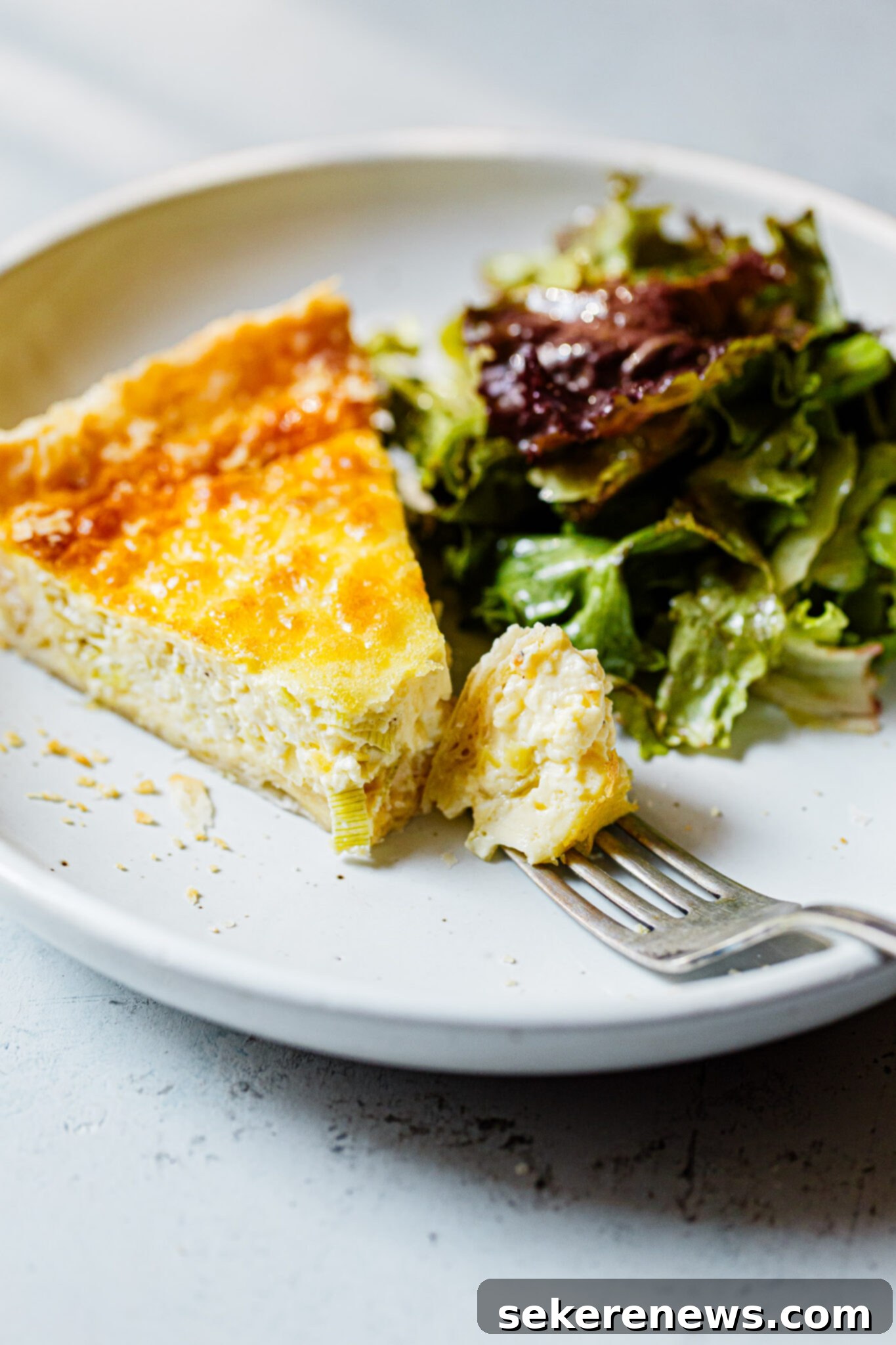Mastering the Classic: The Ultimate Gruyère Leek Quiche Recipe for a Flaky Crust and Silky Custard
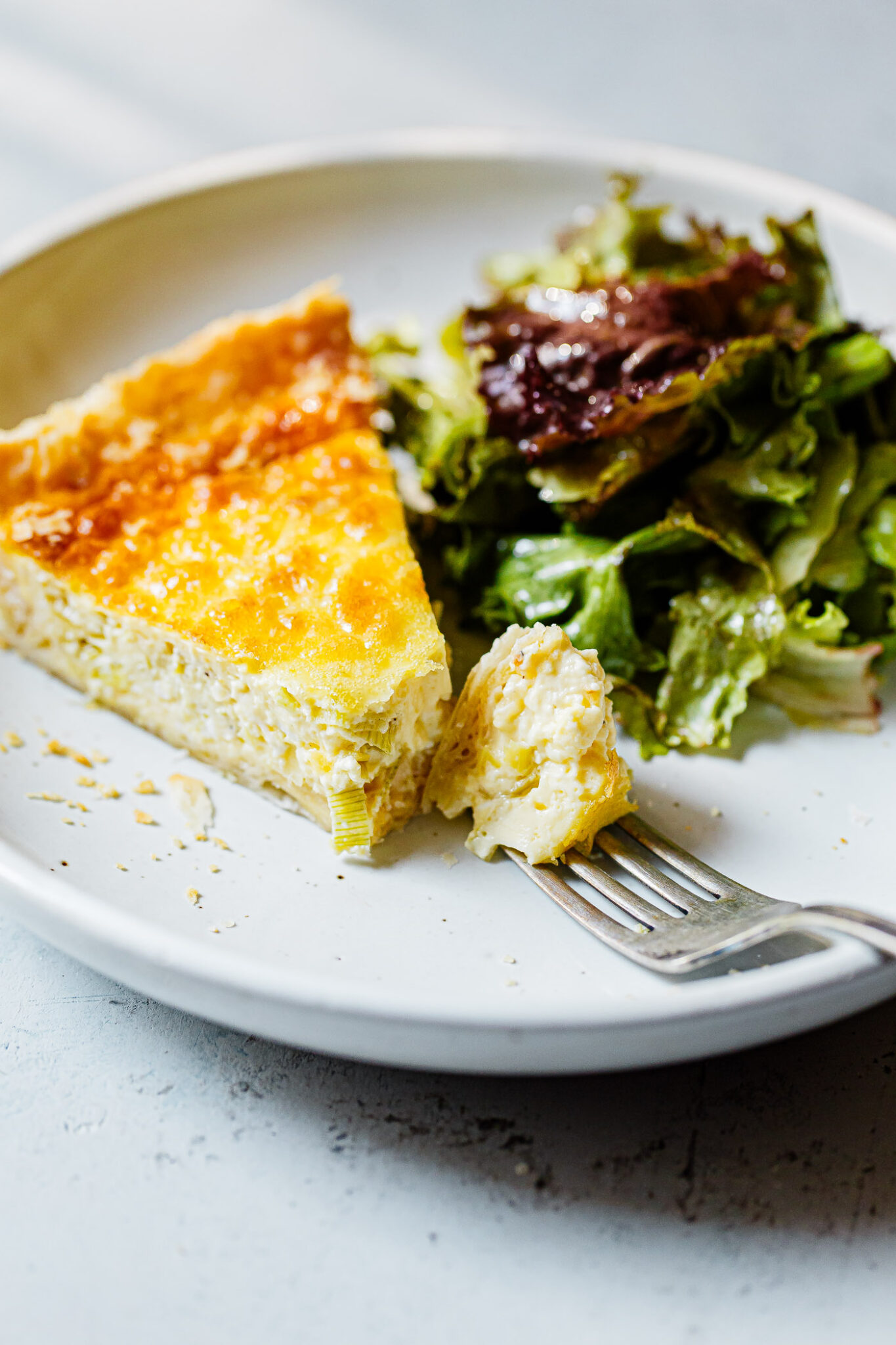
A truly classic French quiche is a culinary marvel, defined by its exquisitely tender, rich custard and a light, flaky, buttery crust. When perfectly executed and served alongside a crisp, fresh green salad, it transcends mere food, becoming one of life’s most satisfying and cherished meals. It’s an elegant dish that effortlessly graces any table, from a casual brunch to a sophisticated dinner.
However, many people often overlook quiche, or sometimes even underrate it. This is largely due to the abundance of subpar, uninspiring versions out there – dry, rubbery custards in soggy crusts that leave a lasting impression for all the wrong reasons. These disappointing experiences can unfortunately lead many to believe that quiche is simply not for them.
Having cultivated a deep passion for quiche over the years, and armed with invaluable insights from my time in French culinary school, I’ve perfected a recipe that elevates this humble dish to its deserved status. Today, I am thrilled to share my ultimate Gruyère Leek Quiche recipe. This isn’t just any quiche; it features my tried-and-true flaky quiche crust, combined with expert techniques to ensure an authentically creamy, savory, and truly unforgettable experience. Prepare to rediscover your love for classic French quiche.
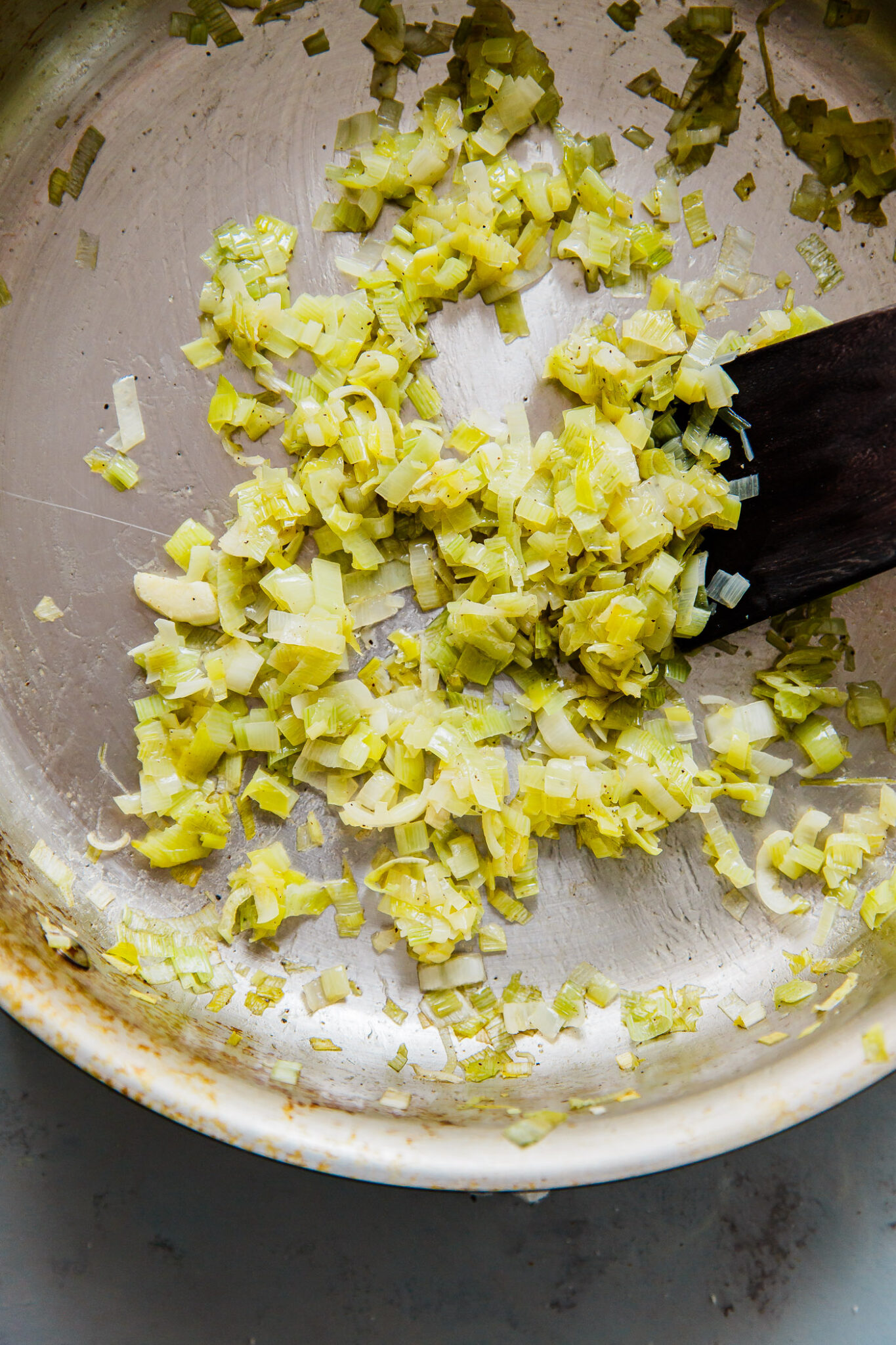
Why You’ll Love This Gruyère Leek Quiche Recipe:
- Unrivaled Texture: The secret to achieving a custard that is unbelievably silky, tender, and savory lies in the “low and slow” baking method. This Gruyère Leek Quiche bakes gently at 325°F (165°C). Cooking proteins like eggs at a lower temperature prevents them from curdling or becoming rubbery, ensuring they retain maximum fat and moisture. The result is a custard that is just perfectly set, with a delicate, tantalizing jiggle in the very center – the hallmark of a truly exceptional quiche.
- Effortless Meal Prep and Reheating: While making a gourmet quiche from scratch requires a bit of time, its make-ahead capabilities are incredibly rewarding. This leek quiche reheats magnificently, making it an ideal candidate for weekend meal preparation. Bake a large quiche on a Sunday, and you’ll have delicious, quick breakfasts, lunches, or even light dinners ready to go throughout the busy week. For even greater convenience, our quiche crust can be prepared and frozen days, weeks, or even months in advance, significantly reducing your active cooking time. You can also get a head start by sautéing your vegetables and grating your cheese a few days prior.
- Infinitely Adaptable: This base recipe for Gruyère Leek Quiche is wonderfully versatile, allowing you to customize it to your taste and what you have on hand. Feel free to swap out the leeks for other complementary sautéed or roasted vegetables, such as earthy mushrooms, vibrant broccoli florets, fresh asparagus, or sweet caramelized onions. For a classic Quiche Lorraine twist, consider adding crispy bits of bacon or pancetta. Don’t hesitate to experiment with fresh herbs like fragrant dill, bright parsley, or aromatic fresh thyme to add another layer of flavor. The key to successful substitutions is to use a similar volume of ingredients and always cook down any fresh vegetables beforehand to reduce their water content, preventing a watery custard.
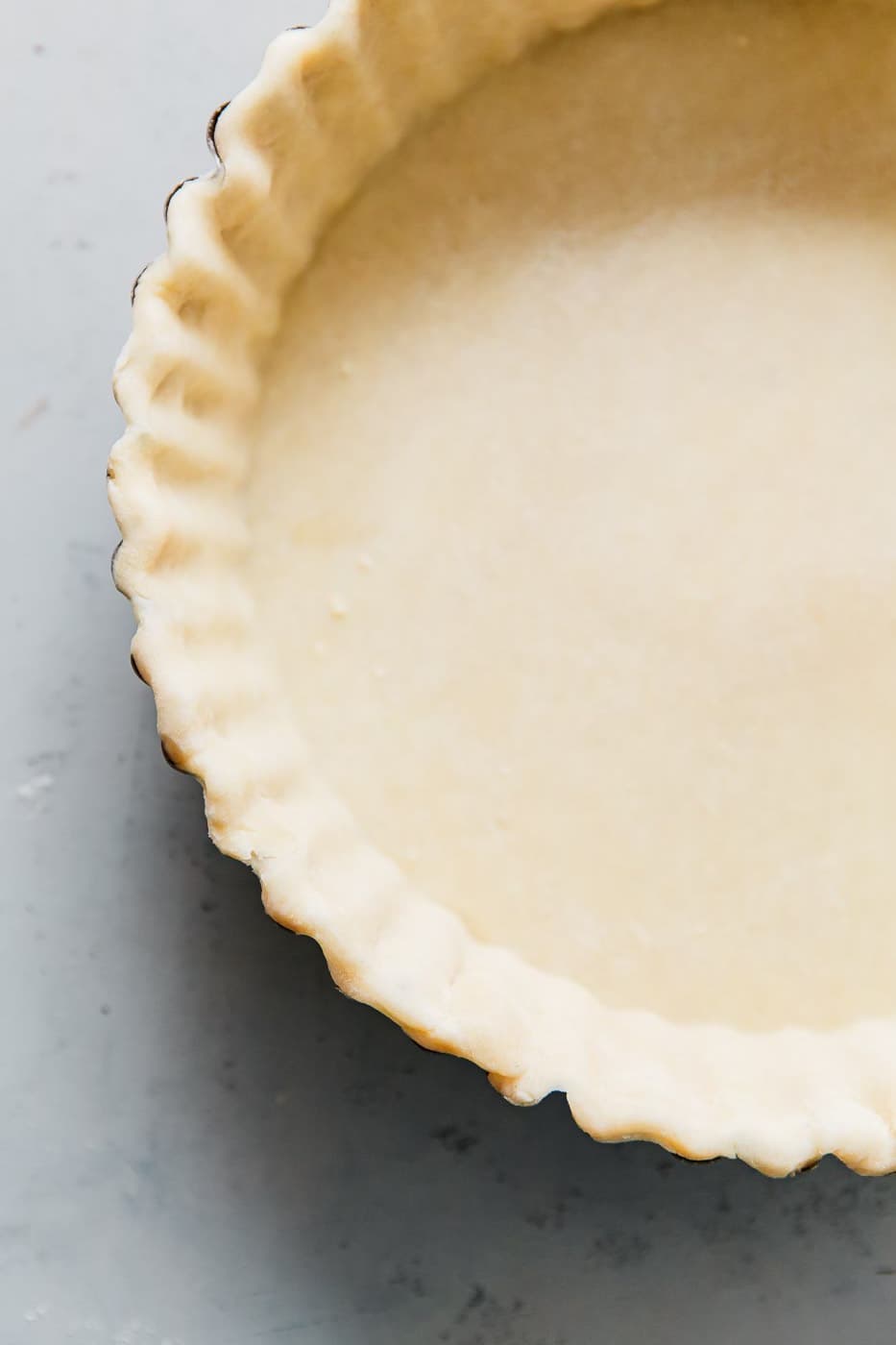
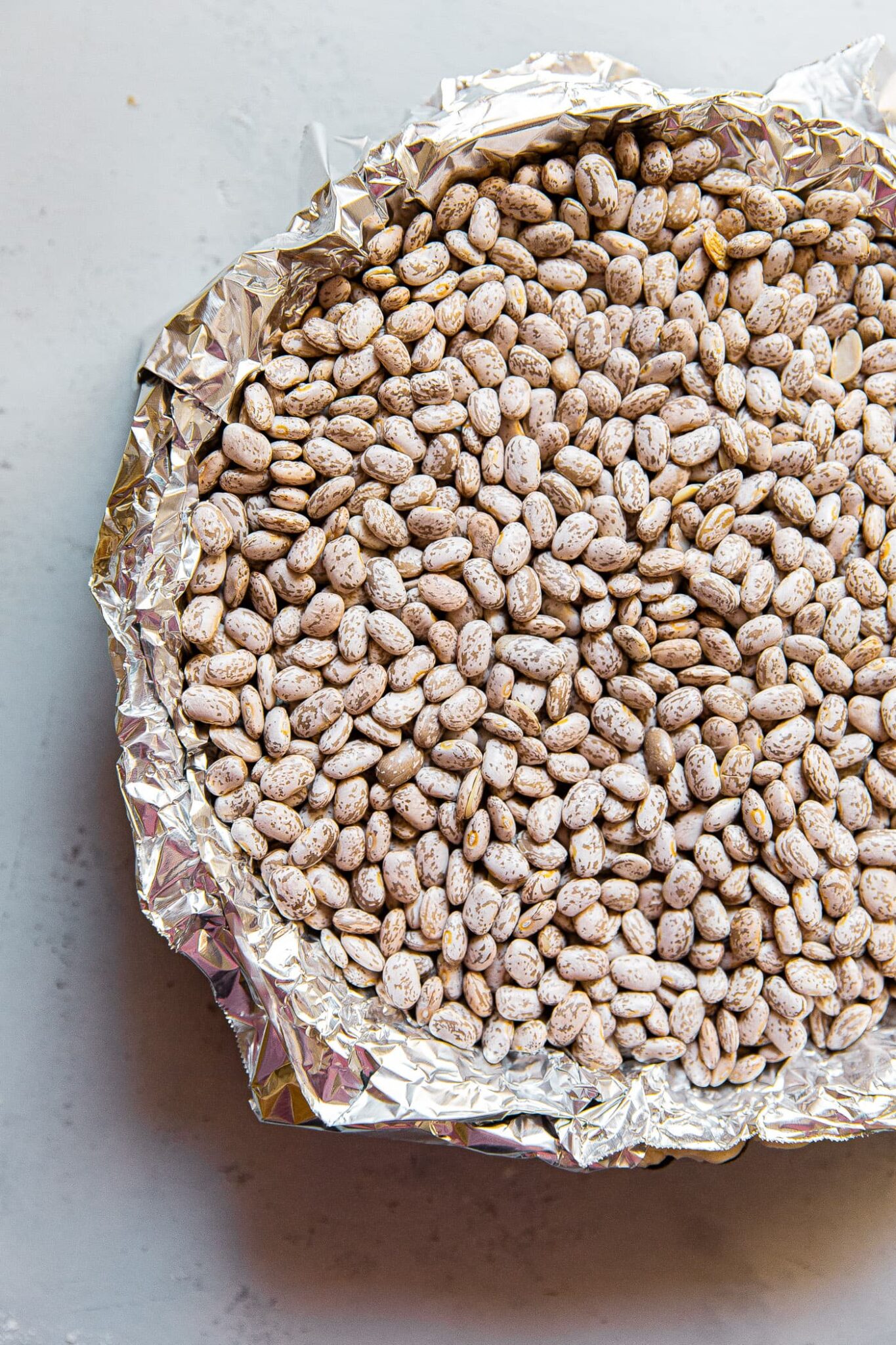
Key Components of This Perfect Gruyère Leek Quiche:
- The Prebaked Crust: This is arguably the most critical step to prevent a common quiche pitfall: a soggy bottom. By blind-baking the pie shell before adding the wet custard, you ensure the crust cooks through and becomes wonderfully flaky, maintaining its structural integrity and delightful texture. This specific quiche crust recipe is designed to be sturdy yet tender, and most importantly, it resists shrinking, allowing it to hold a generous, decadent volume of custard without compromise.
- Rich Gruyère Cheese: Known for its distinctive nutty, earthy, and slightly sweet flavor, Gruyère is the quintessential cheese for a classic French quiche. Its superior meltability ensures a beautifully smooth and integrated cheese layer within the custard, adding depth and a luxurious richness. If Gruyère is unavailable, a well-aged sharp white cheddar makes an excellent alternative, offering a robust flavor profile that complements the leeks beautifully.
- Sweet Sautéed Leeks: Leeks bring a delicate, sweet onion flavor to the quiche that is more refined and less pungent than regular onions. Sautéing them slowly until they are incredibly soft and translucent allows their sweetness to fully develop, making them virtually melt into the baked custard. For those who prefer a different allium, sautéed shallots offer a milder, sweeter option, while yellow onion provides a more classic, assertive flavor. Even thinly sliced green onions can be used for a lighter, fresher taste.
- The Silky Egg Custard: This quiche features an authentic French egg custard, meticulously prepared with the classic ratio of 1 whole large egg to ½ cup of heavy cream. This isn’t a recipe to skimp on dairy; quiche is, in essence, more cream than egg, and this precise balance is crucial for achieving an exceptionally silky, smooth, and deeply flavorful filling. To further enhance the taste, I incorporate freshly grated nutmeg for warmth and a touch of Dijon mustard, which subtly brightens the overall flavor without being overpowering. (See below for important notes on dairy substitutions.)
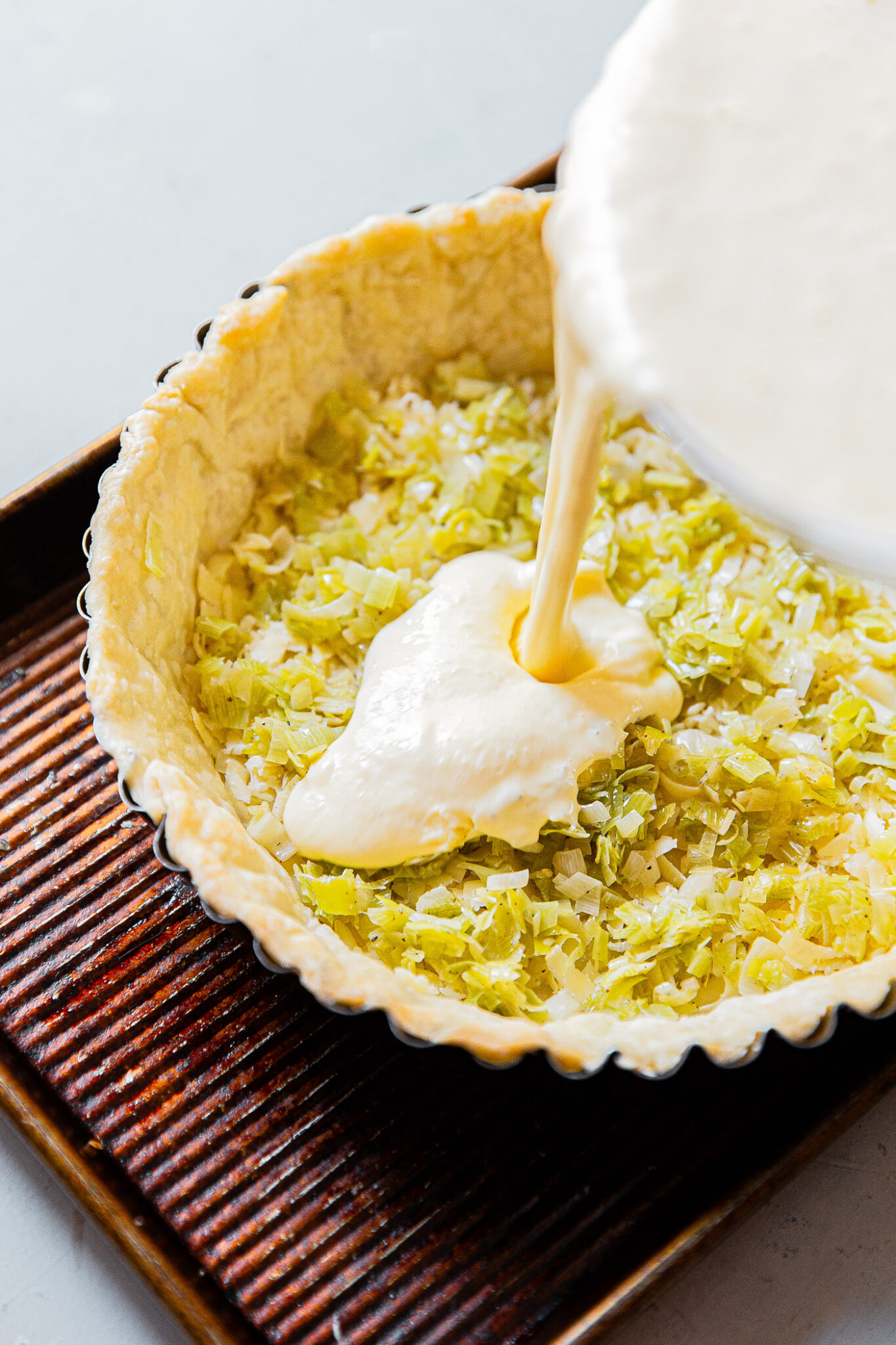
Can I Substitute Heavy Cream with Other Dairy in Quiche?
While exploring different options in cooking is generally encouraged, there’s a very good reason why classic French quiches traditionally rely on heavy cream, and often in substantial quantities. The answer lies in the dairy fat content and its profound influence on the quiche’s ultimate flavor, luxurious texture, and satisfying mouthfeel.
Heavy cream boasts a fat content that typically exceeds 35%, which is significantly higher than the relatively meager 3.5% fat found in whole milk. This considerable difference is absolutely critical, especially when crafting delicate egg custards. The high fat content in heavy cream helps to create a stable emulsion with the eggs, resulting in a rich, velvety smooth custard that doesn’t easily curdle or weep liquid during baking.
Certainly, it is *possible* to opt for whole milk or a combination of milk and cream, but it’s important to understand that such substitutions will simply not deliver the same superior texture or profound flavor that makes a classic quiche truly exceptional. This recipe is designed to be an authentic French quiche, not a lighter frittata or an egg pie made with compromises. Our singular goal here is to craft a quiche that is authentically classic, outstanding in both taste and texture, thereby ensuring that the effort and time you invest are truly worthwhile and yield spectacular results.
Still contemplating swapping the cream for something else? If you absolutely must deviate, using half-and-half (which has a lower fat content than heavy cream but more than milk) is an option, but please be prepared for a noticeable difference in the custard’s texture – it will be less rich and silky. However, I strongly advise against using only whole milk; this particular recipe has been extensively tested, and whole milk simply will not produce the desired, luxurious results characteristic of a true French quiche. Trust the cream for the best experience!

Storing and Reheating Your Gruyère Leek Quiche:
Proper storage ensures your delicious Gruyère Leek Quiche remains fresh and enjoyable. Store any leftover quiche tightly covered in the refrigerator for up to 5 days. For longer preservation, quiche freezes beautifully for up to 3 months. When freezing, it’s best to cut the quiche into individual slices, wrap each portion tightly in aluminum foil, and then place them in a freezer-safe Ziplock bag or airtight container. There’s no need to thaw before reheating, which makes it perfect for quick meals!
To reheat your quiche: Preheat your oven to a moderate 325°F (165°C). For quicker and more even warming, slice the quiche into individual portions if it’s not already. Arrange the slices on a parchment-lined sheet pan. Bake for approximately 15 to 25 minutes, with the exact time depending on the size and thickness of your slices, until the quiche is heated through to the center. Serve immediately and enjoy the comforting flavors all over again!
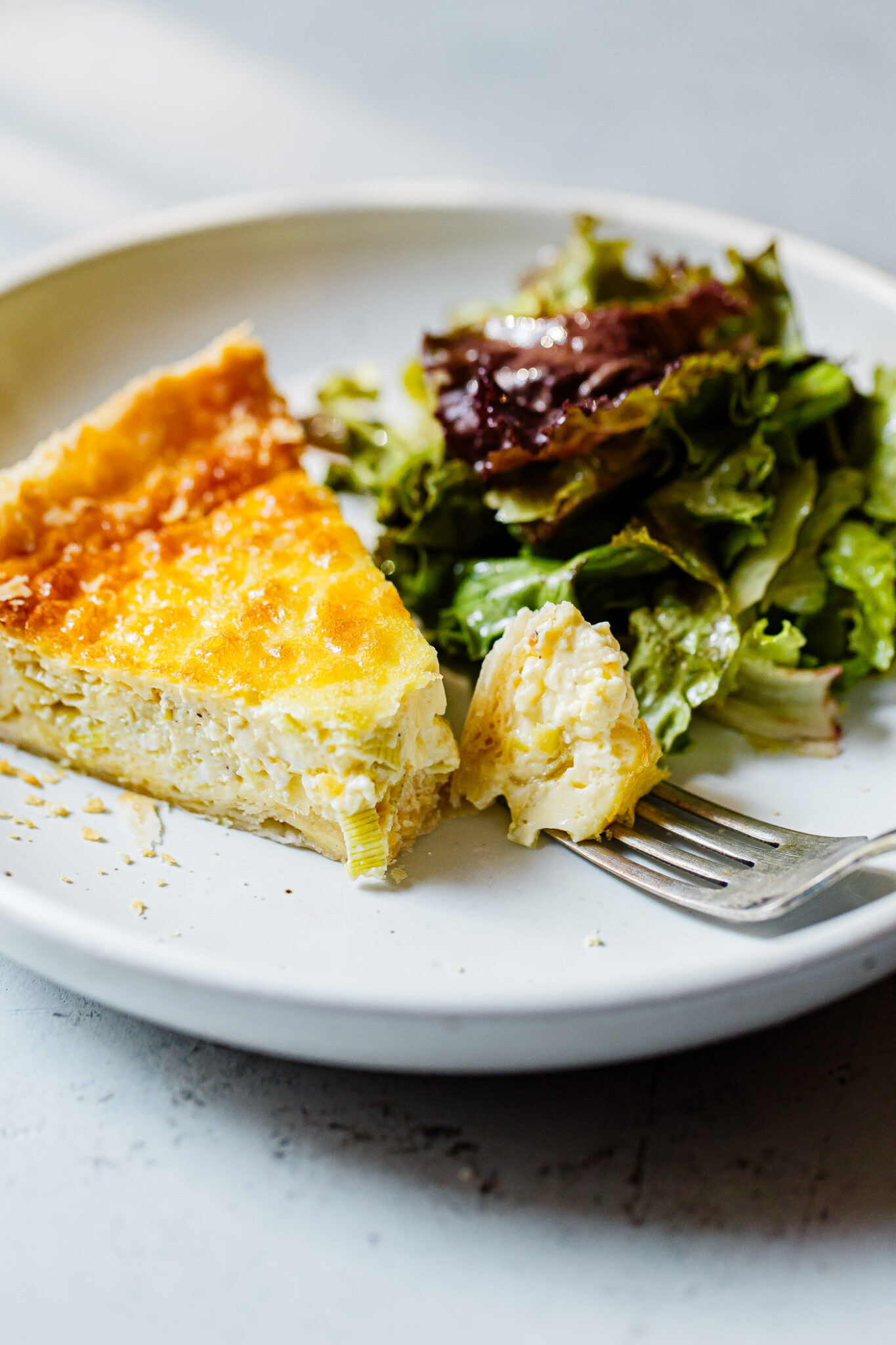
Serving Suggestions for Your Perfect Quiche:
Whether you’re enjoying it for a leisurely breakfast, a satisfying lunch, or an elegant dinner, quiche pairs beautifully with a simple yet vibrant side. My absolute favorite accompaniment is a crisp, leafy green salad. The fresh greens provide a delightful textural contrast to the rich, creamy quiche. To perfectly balance the richness of the custard, toss your salad with a bright and acidic vinaigrette, such as this easy lemon vinaigrette. This acidity cuts through the fat, refreshing your palate with every bite. You might also consider a light fruit salad for brunch or a bowl of creamy tomato soup for a cozy dinner pairing.
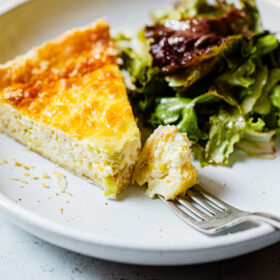
Gruyère Leek Quiche
Ingredients
Crust:
- 1 9-Inch Prebaked Quiche Crust
Filling:
- 1 large leek, white and light green parts only (200g) sliced lengthwise, thoroughly washed, and thinly sliced
- 1 tablespoon (15g) unsalted butter
- 1 tablespoon (15 ml) extra virgin olive oil
- ½ teaspoon kosher salt
- 2 ounces (60g) grated Gruyère cheese
Egg Custard:
- 4 large eggs
- 2 cups (480 ml) heavy cream
- 1 teaspoon Dijon mustard
- ¾ teaspoon kosher salt
- ¼ teaspoon freshly grated nutmeg or freshly grated black pepper
Instructions
- Important Note: This recipe specifically calls for a 9-inch prebaked quiche crust, ideally one that is on the deeper side to accommodate the generous custard. While you can prepare this quiche in a shallower tart or pie pan, it may not hold the full volume of custard specified in this recipe. If your pan is shallow, you can either reduce the custard quantity (maintaining the 1 whole egg: ½ cup cream ratio) or bake any leftover custard in a small ramekin (for a delicious crustless quiche!) at 325°F (165°C) until just set.
- Preheat your oven to 325°F (165°C) and ensure an oven rack is placed in the center position. Carefully place your prebaked quiche crust onto a rimmed sheet pan – this makes transferring it to and from the oven much easier and catches any potential spills. Set aside.
- Sauté the Leeks: In a medium-sized skillet, warm the unsalted butter and extra virgin olive oil over medium-low heat. Once the butter has melted and begins to bubble gently, add the thinly sliced leeks to the pan and sprinkle them with ½ teaspoon of kosher salt. Cook, stirring frequently to prevent browning, until the leeks are incredibly soft and tender, which typically takes about 10 to 12 minutes. If the pan appears dry or the leeks start to color, add a small splash of water (1-2 tablespoons) to help them steam and soften. Once cooked, transfer the sautéed leeks to a small bowl to cool slightly while you prepare the custard.
- Prepare the Custard: In a separate medium-sized bowl, combine the 4 large eggs, 2 cups of heavy cream, 1 teaspoon of Dijon mustard, ¾ teaspoon of kosher salt, and ¼ teaspoon of freshly grated nutmeg (or black pepper). Whisk all the ingredients together thoroughly until the mixture is completely smooth and well combined. Avoid over-whisking, which can introduce too much air.
- Assemble and Bake: Begin by evenly sprinkling the grated Gruyère cheese over the bottom of your prebaked crust. Next, distribute the cooled, sautéed leeks in an even, thin layer over the cheese. Carefully pour the prepared egg custard over the leeks and cheese; the custard should fill the crust almost to the very top edge. With utmost care, transfer the sheet pan with the quiche to the preheated oven. Bake for 40 to 55 minutes, or until the top is lightly golden brown and the custard appears set around the edges but still has the slightest, most delicate jiggle in the very center when gently shaken. This slight jiggle indicates a perfectly tender, not overcooked, custard. Remove from the oven and set on a wire rack to cool for 10 to 15 minutes before slicing and serving. This resting period allows the custard to fully set. Serve warm or at room temperature.
Flavor Variation Ideas for Your Leek Quiche:
- Feel empowered to customize this recipe! Instead of leeks, consider other sautéed or roasted vegetables like savory mushrooms, vibrant broccoli, fresh asparagus spears, or sweet caramelized onions.
- For a heartier quiche or a twist on Quiche Lorraine, add crispy pancetta or bacon bits. Make sure they are fully cooked and drained of excess fat before adding to the quiche.
- Enhance the aromatic profile by experimenting with fresh herbs such as bright dill, earthy parsley, or fragrant fresh thyme. Add them to the custard mixture.
- Key Tip for Variations: Always maintain a similar volume of added ingredients to ensure your quiche bakes correctly. Crucially, cook down (sauté or roast) any fresh vegetables thoroughly to minimize their water content, which prevents a watery custard.
Substitution Notes on Dairy for Optimal Quiche Custard:
- As highlighted, heavy cream’s high fat content (over 35%) is fundamental to creating the luxurious, silky, and tender texture of a classic French egg custard. Whole milk, with its mere 3.5% fat, simply cannot replicate this.
- Using whole milk or even a milk-cream combination will result in a custard that is noticeably less rich, more prone to a firmer, potentially rubbery texture, and may lack the depth of flavor characteristic of an authentic quiche.
- Remember, this recipe is designed for a true classic French quiche – a rich, satisfying dish – not a lighter frittata. Our aim is an exceptional taste and texture that truly justifies the effort.
- If you must substitute, half-and-half is the only recommended alternative, though it will still yield a slightly less opulent custard. Please avoid using whole milk entirely, as extensive testing has shown it does not produce the desired, high-quality results for this particular recipe.
